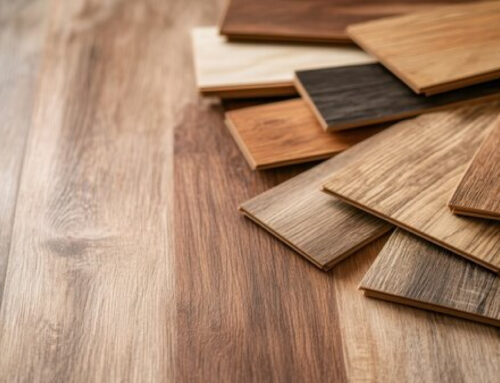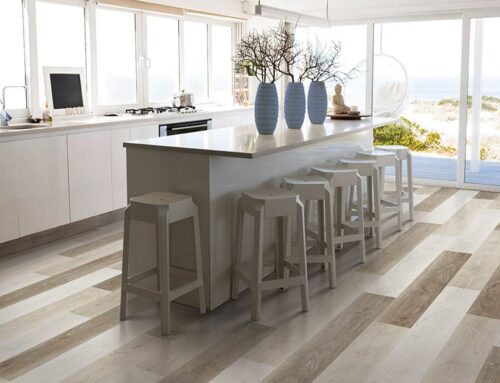[TL;DR]
Choosing between water-based and oil-based stains significantly impacts your wood flooring project’s success.
- Water-based stains dry in 1-2 hours with minimal odor and easy cleanup, making them ideal for occupied spaces and quick turnarounds.
- Oil-based stains require 6-24 hours to dry but penetrate deeper, offering richer colors and 7-10 years of durability compared to water-based stains’ 5-7 years.
Cost considerations include higher material prices for water-based options but lower labor costs due to faster application.
Wood stains enhance natural grain patterns while providing color and protection to flooring surfaces. Choosing the right wood stain determines your flooring project’s success, appearance, and maintenance requirements. The decision between water-based and oil-based stains impacts everything from drying time to long-term durability.
The stain choice affects project timelines, indoor air quality, color richness, and maintenance frequency. Professional flooring contractors need reliable guidance to recommend the best option for each client’s specific needs.
Need guidance on refinishing hardwood floors or staining new installations? Our experts at Rustic Wood Floor Supply have the premium stains and expert advice you need to deliver stunning results that impress every client.
Connect with Experts: (678) 691-0533
What is a Water-Based Stain?
Water-based stains use water as the primary solvent, carrying colorants and resins into wood fibers. These modern formulations dry through water evaporation rather than chemical oxidation.
Water based finishes contain acrylic or polyurethane resins suspended in water. The water carries pigments into wood pores while leaving protective resins on the surface. Modern formulations provide excellent color clarity and consistency.
Typical uses include indoor:
- Hardwood floors
- Light-colored woods
- Projects requiring quick turnaround times
Drying characteristics allow recoating within 2-4 hours under normal conditions.
Market Surge:
The growing preference for environmentally friendly options is evident in the global water-based wood coatings market, valued at $3.5 billion in 2023 and projected to grow at 6.5% annually through 2030.
What is an Oil-Based Stain?
Oil-based stains use petroleum distillates or natural oils as solvents, carrying pigments deep into wood pores. These traditional formulations cure through oxidation and solvent evaporation.
Oil-based stains contain alkyd resins, natural oils, and colorants dissolved in mineral spirits. The oil-based solvents penetrate deeply into wood fibers, creating strong chemical bonds with the wood structure.
Typical uses include:
- Outdoor decking
- Dense hardwoods
- Projects requiring maximum durability
Drying characteristics require 8-24 hours before applying topcoats, depending on temperature and humidity.
Growth Trends:
Despite the rise of water-based alternatives, oil-based stains maintain strong market demand with U.S. sales estimated at $628.5 million in 2024. This substantial market presence reflects the continued preference for oil-based durability in flooring applications.
5 Key Differences Between Water-Based and Oil-Based Stains
Understanding performance differences between water-based and oil-based stains helps professionals make informed recommendations based on specific project requirements and client needs.
1. Drying Time and Project Timeline
Water-based stains dry completely within 1-2 hours under normal conditions. This rapid drying allows same-day topcoat application, significantly reducing project timelines. The quick turnaround means contractors can complete staining and protective coating in a single day, maximizing efficiency and reducing labor costs.
Oil-based stains take several hours to a full day for complete drying. Extended drying times can delay project completion but provide longer working times for adjustments. Temperature and humidity significantly affect oil-based drying, often requiring overnight waiting periods before applying protective topcoats.
2. Odor and VOC Emissions
Water-based finishes produce minimal odor during application and curing. VOC emissions remain below 250 grams per liter, making them environmentally friendly and suitable for occupied buildings.
Oil-based stains emit strong chemical odors, requiring proper ventilation systems. Higher VOC content exceeds 450 grams per liter, potentially causing health concerns and requiring extensive ventilation during application.
3. Color and Appearance
Water-based stains produce lighter, more vibrant colors with minimal grain enhancement. Colors appear cleaner and maintain consistency over time without yellowing or ambering effects. These formulations work exceptionally well on light woods where color clarity matters most.
Oil-based stains create richer, darker colors while dramatically enhancing wood grain patterns. These formulations develop warmer tones through enhanced penetration but may change color over time. The deep saturation brings out natural wood character and creates the traditional rich appearance that many clients prefer for classic hardwood flooring installations.
4. Penetration and Durability
Water-based stains form a surface film with moderate penetration into wood fibers. They provide good protection but may require more frequent reapplication in high-traffic areas. These formulations last 5-7 years before requiring maintenance.
Oil-based stains penetrate deeper into wood fibers, providing longer-lasting protection and color retention. Deep penetration creates stronger bonds that resist wear and moisture in high-traffic flooring applications. This superior durability provides 7-10 years of protection.
- Cost and Application Complexity
Water-based stains cost 20-30% more per gallon but offer significant labor savings through faster application cycles. Quick drying reduces project duration and allows contractors to complete more jobs. Easy soap-and-water cleanup eliminates solvent expenses and disposal costs.
Oil-based stains have lower upfront material costs but require complex application planning and longer timelines. Extended drying periods increase labor duration, while solvent-based cleanup adds material and disposal costs. However, longer intervals between reapplications can offset initial expense differences.
Industry Insight:
Current market trends show water-based stains command 55% of interior wood stain sales due to their environmental benefits. In contrast, oil-based formulations maintain a strong 40% market presence for projects requiring maximum durability and traditional appearance.
Comparison Table
| Feature | Water-Based Stains | Oil-Based Stains |
| Drying Time | 1-2 hours | 6-24 hours |
| Odor Level | Low/Minimal | Strong |
| VOC Content | Under 250 g/L | Over 450 g/L |
| Cleanup | Soap and water | Mineral spirits |
| Penetration | Surface film + moderate | Deep penetration |
| Color Appearance | Lighter, vibrant | Richer, darker |
| Durability | 5-7 years | 7-10 years |
| Cost | Higher material cost | Lower material cost |
| Grain Enhancement | Minimal | Excellent |
| Environmental Impact | Low VOC, eco-friendly | Higher VOC emissions |
Pros and Cons of Water-Based Stains
Water-based finishes excel in convenience and environmental benefits while offering specific performance characteristics for modern flooring projects.
Pros include:
- Quick drying enables faster project completion
- Low odor allows work in occupied spaces
- Easy cleanup with soap and water reduces costs
- Environmentally friendly with low VOC emissions
- Excellent color retention prevents yellowing
- Compatible with modern polyurethane finishes
Cons include:
- Can be harder to apply evenly on some woods
- May appear streaky without proper technique
- Requires moderate maintenance frequency
- Higher material costs than oil-based alternatives
- Less grain enhancement reduces character
- May require multiple coats for opacity
Professional flooring contractors appreciate the quick turnaround times and convenience that water-based finishes provide for tight project schedules.
When speed and convenience matter most for your flooring projects, Rustic Wood Floor Supply’s premium water-based stains deliver professional results without compromising quality. Our low-VOC formulations meet environmental standards and provide the fast-drying performance contractors demand.
Pros and Cons of Oil-Based Stains
Oil-based stains provide traditional benefits that many flooring professionals prefer for specific applications requiring maximum durability.
Pros include:
- Deep penetration creates lasting color bonds
- Durable finish withstands heavy traffic
- Rich color development enhances wood beauty
- Longer working time allows corrections
- Superior adhesion to dense hardwoods
- Traditional appearance preferred by many clients
Cons include:
- Long drying time delays project completion
- Strong odor requires ventilation planning
- Higher VOCs impact indoor air quality
- More expensive cleanup requiring solvents
- Potential color changes over time
- Environmental regulations may restrict use
For projects demanding maximum durability and rich color depth, Rustic Wood Floor Supply’s oil-based stains provide the deep penetration and longevity that high-end flooring installations require. Our traditional formulations deliver the premium results that discerning clients expect.
3 Major Application Considerations
Proper application techniques and project planning vary significantly between water-based and oil-based stain formulations.
1. Ease of Use and Cleanup
Water-based stains clean up easily with soap and water, eliminating solvent costs and disposal concerns. Brushes and equipment rinse clean without special chemicals or environmental disposal requirements.
Oil-based stains require mineral spirits or paint thinner for cleanup. Contaminated materials need proper disposal following local environmental regulations, adding cost and complexity to project completion.
Application factors:
- Water-based works with synthetic applicators
- Oil-based stains require natural bristle brushes
- Cleanup time affects labor costs significantly
- Environmental disposal adds project complexity
2. Suitable Wood Types and Projects
Water based finishes work exceptionally well on lighter woods like maple, ash, and birch, where color clarity and brightness matter most for modern flooring designs.
Oil-based stains excel on dense woods such as oak, walnut, and cherry, where deep penetration enhances natural grain characteristics and provides rich, warm tones.
Project suitability:
- Indoor residential floors favor water-based convenience
- Commercial spaces may require low-VOC options
- Outdoor applications benefit from oil-based durability
- High-traffic areas need oil-based protection
3. Environmental and Health Factors
VOC regulations increasingly favor water-based stains in commercial and residential applications. Many jurisdictions limit high-VOC products in occupied buildings and sensitive environments.
Sensitivities to odors and fumes make water-based finishes the preferred choice for healthcare facilities, schools, and homes with sensitive occupants. Indoor air quality considerations often determine stain selection.
Health and safety factors:
- Chemical sensitivity requirements
- Ventilation system capabilities
- Regulatory compliance needs
- Long-term exposure concerns
3 Common Mistakes to Avoid When Choosing Stains
Even experienced contractors can make costly stain selection errors that compromise project outcomes and client satisfaction. Here are the three most common mistakes to avoid when choosing stains:
1. Temperature and Weather Mistakes
Applying water-based stains in high humidity conditions can cause extended drying times and poor adhesion. Cold temperatures below 50°F significantly slow water evaporation, leading to uneven application and potential clouding effects.
Oil-based stains become problematic in hot weather above 85°F, causing rapid surface drying that prevents proper penetration. High temperatures create lap marks and uneven color distribution across large flooring areas.
2. Wood Preparation Errors
Failing to properly sand and clean wood surfaces before staining leads to blotchy, uneven color absorption. Water-based stains are particularly sensitive to surface contaminants like dust, oils, and previous finish residues.
Oil-based stains require complete removal of any water-based products from previous treatments. Mixing incompatible stain types without proper preparation creates adhesion failures and finish delamination over time.
3. Application Technique Problems
Rushing water-based stain application often results in streaky finishes and visible overlap marks. The fast drying time demands efficient, systematic application patterns and immediate blending of wet edges.
Over-applying oil-based stains creates thick, gummy surfaces that never fully cure. Excess stain must be wiped away within the working time to prevent tacky, uneven finishes that attract dirt and wear prematurely.
When to Recommend Each Stain Type?
Project requirements, client preferences, and environmental factors determine the best stain choice for each flooring installation.
Choose water-based stains when you need:
- Fast project completion with same-day topcoat application
- Low odor for occupied spaces like homes and offices
- Easy cleanup to reduce labor costs and time
- Environmental compliance for green building projects
- Bright, true colors on light woods like maple or ash
Choose oil-based stains when you need:
- Maximum durability for high-traffic areas
- Rich, deep colors that enhance wood grain character
- Long-lasting protection spanning 7-10 years
- Traditional appearance for classic hardwood projects
- Superior weather resistance for outdoor applications
Water based finishes work best for residential projects, quick turnarounds, and environmentally sensitive locations. Oil-based stains excel in commercial settings, outdoor installations, and projects where longevity matters most.
Bottom Line
Water-based stains offer speed and convenience, while oil-based stains provide durability and rich color development. Consider client needs, local regulations, wood types, and application environments when making recommendations. Both stain types have their place in professional flooring applications when properly matched to project requirements.
Don’t let stain selection make or break your flooring project!
At Rustic Wood Floor Supply, we eliminate the guesswork with premium water-based and oil-based stains backed by expert guidance that guarantees stunning results. Our flooring specialists work alongside you to match the perfect stain to your project’s unique demands, whether you need lightning-fast turnaround times or decades of durability.
Stop settling for mediocre finishes when you could be delivering showroom-quality floors that wow clients and build your reputation. Get in touch with our team!
Frequently Asked Questions
What are the main differences between water-based and oil-based wood stains?
Water-based stains dry faster with low odor and easy cleanup, while oil-based stains penetrate deeper, offer richer colors, and provide superior durability lasting 7-10 years versus water-based 5-7 years for flooring applications.
Which stain is better for outdoor wood projects?
Oil-based stains excel outdoors due to superior weather resistance, deeper wood penetration, enhanced UV protection, and longer-lasting durability against moisture, temperature changes, harsh environmental elements, and natural weathering conditions over time.
Can I apply water-based stain over oil-based stain or vice versa?
Direct application isn’t recommended without proper surface preparation. Previous coatings must be completely removed, sanded, or primed with compatible products to ensure proper adhesion and performance.
Are water-based stains less durable than oil-based stains?
Yes, water-based stains typically last 5-7 years while oil-based stains last 7-10 years due to deeper wood penetration, stronger chemical bonding with wood fibers, and superior resistance to wear and environmental factors.
Author Profile
- I have worked in hardwood flooring for the last 8 years. Use to run a company of residential crews as well as a company with gym flooring. If you need floor installation or refinishing help, I should have an answer or at least get you in the right direction.
Latest entries
 FlooringDecember 24, 2025Right Advice For Picking The Ideal Hardwood Flooring Options
FlooringDecember 24, 2025Right Advice For Picking The Ideal Hardwood Flooring Options FlooringDecember 22, 2025What is Your Favorite Type of Hardwood Flooring and Why?
FlooringDecember 22, 2025What is Your Favorite Type of Hardwood Flooring and Why? FlooringDecember 15, 2025What is the Most Durable Engineered Hardwood Flooring?
FlooringDecember 15, 2025What is the Most Durable Engineered Hardwood Flooring? FlooringDecember 12, 2025How Do You Maintain Vinyl Flooring in Spokane Homes?
FlooringDecember 12, 2025How Do You Maintain Vinyl Flooring in Spokane Homes?




